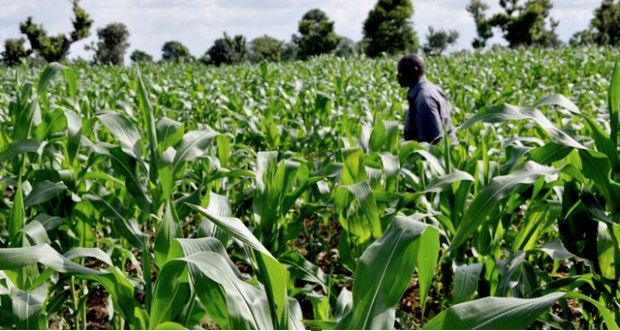
Planting for Food and Jobs: A success story worth telling
The concept of the agricultural flagship programme - Planting for Food and Jobs (PFJ) - reveals a policy introduced by the government to address the declining growth in the country’s agricultural sector.
It was launched on April 19, 2017 at Goaso in the Ahafo Region and spearheaded by the Minister of Food and Agriculture, Dr Owusu Afriyie Akoto, whose aim has been to carry the PFJ Campaign with passion, precision and success into the future.
Advertisement
The PFJ was introduced to encourage Ghanaians to take farming more seriously than in the recent past and aims to make farming once more a respectable and profitable venture and create jobs.
Modules
It is a campaign with five implementation modules, starting with the PFJ itself, which promotes food security via crops, namely: maize, rice, sorghum, soybean, and vegetable crops (onion, tomato, pepper, etc.). This has since been expanded to include groundnut, cabbage, carrots, cucumber, lettuce, cassava, cowpea, plantain and Orange Flesh Sweet Potato.
The second module, which focuses on expanding the cash crops, is known as the Planting for Export and Rural Development (PERD), while the Rearing for Food and Jobs (RFJ) seeks to address the meat deficit in the country through the rearing of animals such as cattle, goats, sheep, pigs, fowls and guinea fowls.
The Greenhouse Villages Technology is one that focuses at ensuring that there is sufficient vegetables for both local and international markets while the Agricultural Mechanisation Service Centres (AMSECs) aims at mechanising agriculture through the use of hand-held implements and modernising agriculture.
Selected crops
In 2017 when the PFJ was launched, the focus was on Maize, Rice, Sorghum, soybeans, tomato, Onion and Pepper but by the beginning of the 2019 farming season, it included groundnut, cowpea, cabbage, cucumber, lettuce, carrot, cassava, plantain and orange flesh sweet potato (OFSP).
The crops have been selected based on their potential contribution to food security, smallholder farm profitability/increase in incomes, supply of raw materials for the livestock and industrial sectors and the reduction in food import bills.
Patronage
Since its implementation, the patronage has been phenomenal with many more farmers registering under it than anticipated. For instance in 2017, the ministry targeted 200,000 but at the end of the farming season, the figure was 202,000 farmers, while the figure for 2018 exceeded the targeted 500,000 farmers to hit 677,000. For the 2019, it is anticipated that the figure can exceed the one million targeted farmers to over 1.2 million farmers.
Improved seeds & fertiliser
To ensure that the aim of the programme is achieved, in 2017 when it was launched, a total of 4,400 tonnes of certified seeds of cereals (maize, rice, sorghum) and legumes (soya bean) were made available to farmers, including four tonnes of vegetable seeds (tomatoes, onion and pepper). In 2018, a total of nearly 7,000 tonnes of seeds of the various crops, including groundnut and vegetables (lettuce, cucumber, carrot, cabbage etc.) were distributed.
In 2019, it is projected that over 15,000 tonnes of improved seeds would have been made available to farmers under the campaign.
To encourage fertiliser use under the PFJ, a total of 79,943 tonnes of granular fertiliser (25KG) were distributed in 2018 and in 2019, the figure was more than double, increasing to 160,000 tonnes. For the liquid fertilizer, 266,606 litres were distributed in 2018 and shot up to 2,200,000, while the compost went from 36,239 kg in 2018 to 100,000kg in 2019.
In 2017 a total of 228,684 hectares were cropped with maize, rice and soya bean yielding a total output of 697,400 tonnes, while in 2018, from the 373,384 hectares cropped, 1,247,620 tonnes was realised.
Warehousing
With the high yield being recorded on a yearly basis, the focus of the government now has been to promote the role of the private sector in trading, storage and marketing of farm outputs and also to facilitate forward and backward linkages between producers and commodity chain actors.
Consequently, the government has undertaken an aggressive move to provide adequate warehousing facilities to prevent the usual post-harvest losses often associated with bumper harvests.
In line with that the warehousing capacity has been increased from 27 warehouses with the capacity of 34,000 tonnes in 2017 to 160 warehouses with 160,000 tonnes in 2019 at vantage points to ensure that no farm product goes waste.
Obviously this meant that there had been an unprecedented volume of food crops at the end of the 2018 farming season resulting in the export of a total of 150,000 tonnes of main food items to neighbouring countries, such as Burkina Faso, Ivory Coast, Togo, Niger, Benin and Nigeria.
The achievements of the PFJ have attracted a number of neighbouring countries which have expressed interest in coming to learn best practice to enable them to replicate in their respective countries.
Challenges
In spite of the clear indications of success of the PFJ, the Ministry of Food and Agriculture must step up monitoring of people put in charge of supply and distribution of the improved seeds and fertiliser to farmers who sign up onto the programme.
From the ground, it is obvious that some of the suppliers are shortchanging the programme and are taking undue advantage of the illiteracy of majority of the farmers to make millions of cedis at the expense of the farmers.
Those are the group of people Dr Akoto should not allow to derail the effort and passion he has injected into the programme, which has earned him the title Mr Planting for Food and Jobs.



